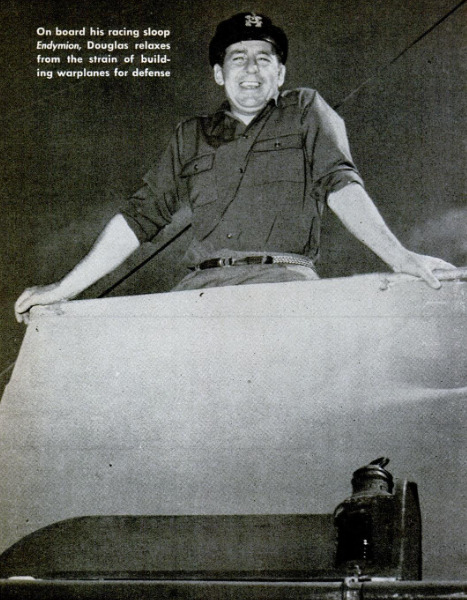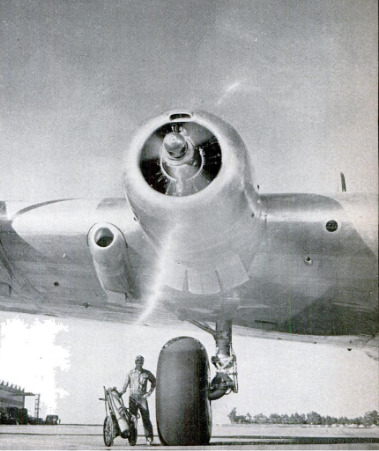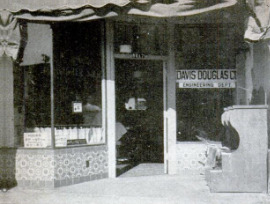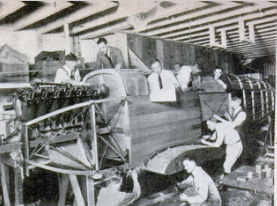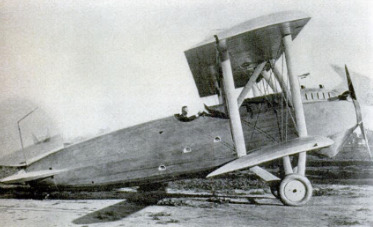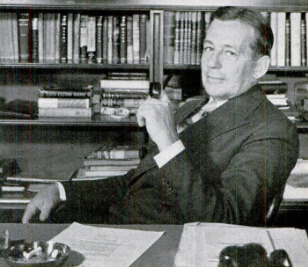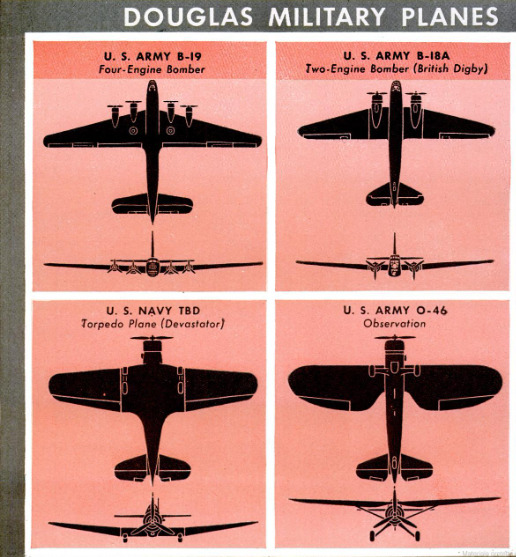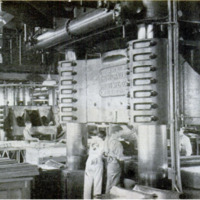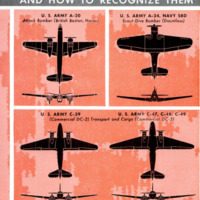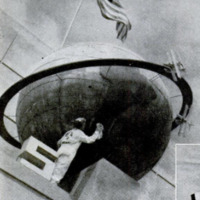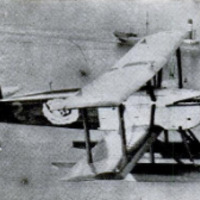-
Title (Dublin Core)
-
2.500.00 worth of planes a day: he built his engineering genius into planed that are fighting our enemies on land and sea
-
Article Title and/or Image Caption (Dublin Core)
-
Title: 2.500.00 worth of planes a day: he built his engineering genius into planed that are fighting our enemies on land and sea
-
extracted text (Extract Text)
-
Donald Douglas set that as a production goal in filling orders for 654,579,973.26 that goal on schadule-just as he has always come through on every job he has ever tackled
ONE afternoon in the early summer of
1909, only six years after the
‘Wright brothers were catapulted
from Kill Devil Hill into the world’s first
heavier-than-airflight, aslender youthnamed
Donald Wills Douglas hurried over from
‘Washington to Fort Meyer, Va., to catch his
first glimpse of an airplane. For an hour, the
famous brothers tossed wisps of dust up to
test the breeze. At last they roared out over
the corral, their chattering engine and beat-
ing propeller frightening men and horses.
Chance got the wide-eyed youth his op-
portunity to be in near the birth of aviation.
He had received an appointment to the U. S.
Naval Academy, subject to a bit of surgery,
and had gone to Washington a few days
earlier to enter a hospital. A few weeks
after observing the dem-
onstration, he became a
plebe, and celebrated by
launching from a dormi-
tory window a model
plane put together by his
own hands. The plane
promptly smacked into
an admiral's cap as that
officer strolled along a
walkway outside.
Thirty-two years later,
the same Donald Doug-
las on an early summer
afternoon walked diffi-
dently from a hangar at
Clover Field, near Santa
Monica, Calif., heard four
powerful engines ticking
methodically on the larg-
est airplane ever built.
The great bird was the
B-19, a bomber capable
of carrying a huge load
of bombs across an ocean
and returning home
again. For miles in all di-
rections, 100,000 people
jammed the highways for
a glimpse of another his-
toric flight. Shortly, the pilot gunned the
engines, and the B-19 soared into the sky.
Between Fort Meyer and Clover Field,
Donald Douglas in three decades has
achieved world eminence in aviation. From
the time he set out to build an airplane, in
1921, until today he has never experienced
failure. His passenger liners span the na-
tion on 17 airlines, serve 52 foreign coun-
tries on another 18 lines; cargo and troop
carriers, dive bombers, medium bombers, and
huge four-engine bombers from his factories
are fighting for Uncle Sam and his allies.
Every day a million dollars’ worth of new
airplanes roll from his assembly lines.
Although his designs have revolutionized
commercial aviation and added mightily to
our aerial defense, Douglas has everlastingly
avoided the spotlight. He'd rather lose a
tooth to the dentist's forceps than make a
speech. Bronzed by frequent week-ends off
the California coast on his racing sloop, he
spends long days at a large desk in a small
office where he devotes his engineering and
business genius to planning new planes to
fight our enemies.
‘As an engineer, he has won the coveted
Collier and Guggenheim awards. From the
business angle, his enterprises have shown
a profit ever since he became a builder of
airplanes 20 years ago, from the two-place
Cloudster, a biplane which introduced new
techniques in streamlining, to his A-24 dive
bomber, so good that Army authorities de-
clared two squadrons “out-Stukaed the Ger-
man Stukas” in the recent large-scale war
games down in Louisiana.
Douglas is a “pilots designer.” Above and
beyond his engineering skill, however, you
find a single-mindedness rare in manufac-
turers. When he left the Naval Academy in
1912, his mind was focused on wings and
skies. That autumn he enrolled in the Mas-
sachusetts Institute of Technology, graduat-
ing two years later and receiving immediate-
ly a year's appointment as assistant in
aeronautical engineering. Salary, $500 per
annum.
Young Douglas moved rapidly during the
next few years. At M.L T. he helped build
the first wind tunnel. Next year found him
at the Connecticut Aircraft Co., building the
first dirigible constructed in the United
States, the D-1. Shortly Glenn L. Martin
brought him to his firm as chief engineer,
and young Douglas’ skill entered into the
design of the famous twin-engine Martin
bomber, a landmark in military aviation.
Now only 25, he already
had won national recog-
nition. Another jump land-
ed him in Los Angeles,
“approximately broke” but
blessed with boundless con-
fidence in his ability. On
the West Coast Douglas
met a wealthy young man
named David R. Davis,
who owned a small ma-
chine shop and wanted to
get into aviation. Douglas
sold Davis on the idea of
building a reconnaissance-
type plane, streamlined
and equipped with instru-
ments. A few months later
the Cloudster, conceived on drawing boards
hugging the wall of a small barber shop,
was perfected.
I talked to Eric Springer, test pilot for
Douglas and Davis when the Cloudster was
born and today manager of the El Segundo
plant, building A-24’s for the Army and
their counterpart, the SBD, for the Navy
and Marine Corps.
“Doug knew where he was headed then,
and he's never given us a chance to forget.
You can think of the Cloudster, or any of
the 150-0dd models since, as a cocktail. It's
got to have the right proportion of all in-
gredients before it's served to a customer.
“Every Douglas ship,” Springer contin-
ued, “represents a compromise. Not the
fastest, maybe, nor the highest-flying, nor
will it carry the heaviest load possible. But
it'll be a pilot's airplane, combining speed,
economy, and loadability.”
Springer and Davis took off from March
Field, the Army flying base in Southern
California, early on the morning of June 25,
1921, hoping to make the first transconti-
nental nonstop flight. They reached El Paso
ahead of schedule, when one bank of the
timing gears failed just as they roared over
Fort Bliss. Springer slid down to a dead-
stick landing, and the attempt was written
off as a failure when Lieutenants Kelly and
Macready made the flight in a single-en-
gine Fokker monoplane a short time later.
The failure was only apparent, however,
for the Navy shortly requested specifica-
tions for a torpedo plane, inviting both
American and European companies to par-
ticipate. The ship was to fly from pon-
tons, and be powered with a 400-horsepow-
er Liberty engine. From the data perfected
in building the Cloudster, Douglas turned
out the winning design, of which the Navy
bought 61 copies. This led to development of
a new series with which U. S. Army officers
in 1924 succeeded in flying 25,000 miles
around the world.
In 1932 the airlines, just crawling up from
the depression, faced the necessity of in-
creasing their speed, providing greater com-
fort for day passengers and beds for those
flying at night, and cutting operating costs.
Early in 1933, TWA officials decided speed
must be upped 50 miles an hour, that other
characteristics of safety and power must be
provided. Douglas and four other manufac-
turers received requests for bids, one re-
quirement being that the plane accepted
must be able to fly from any regular airport
in the country on one engine, proceed to the
next scheduled stop, and have a legal reserve
of gas remaining in the tanks on arrival.
TWA awarded the contract to Douglas, and
a new era in American air transport began.
Douglas built the DC-1 for peacetime fly-
ing. The ship upped cruising speed from 100
miles an hour to 150. With a few changes,
the production model became the DC-2.
Shortly, improvements were incorporated in
a third model, the DC-3. Whereas 186 DC-2's
were built, more than 1,500 DC-3’s will have
been constructed by early next year for the
air lines, and for the U. S. Army for employ-
ment as troop and military cargo carriers.
The DC-3 series gave world travelers their
first taste of real flying comfort, and as they
drew increasing numbers of passengers into
the air, brought the lines out of the red. To-
day these 25,200-pound planes, after five
years without a major structural change,
are still standard equipment.
Sitting at the hub of a large engineering
and manufacturing organization, Douglas
can’t poke his finger into every detail, but
he guides the preliminary design of any new
ship, whether transport or bomber. He leaves
details to his experts.
Seated in the quiet of his paneled office,
we might have been a thousand miles from
the clatter of riveting and roaring of test
engines just beyond the soundproof walls
when I asked him to look into the future.
“Let's start with invisible bombing,” I
said. “How high will the bombers fly?”
“Some of our plans must remain military
secrets,” he warned, “but I can go this far:
Recently we have completed a ‘cold room,”
where the thermometer drops down to about
105 degrees below zero. In that room we're
testing oxygen apparatus, paints which we
hope will not chip and flake in extreme cold,
metals, and men.” The “cold room,” whose
temperatures fall below those flyers experi-
ence at the highest levels any plane today
can reach, is the laboratory where he’s get-
ting ready for stratdspheric bombing.
Douglas considers the fabulous B-19 to
be the guidepost which may usher in an era |
of superbombers of which no more than a
half dozen fighting airmen dared dream as
recently as a year ago.
“Suppose,” he said, “we're asked to jump
from our 30-ton bombers to a machine of |
200,000 pounds. The big fellow might fail
unless we know where we're heading. The
B-19 gives us fine supporting evidence on
which to build a 100-ton bomber. She is a
point from which we may embark on designs
for planes capable of carrying much heavier |
bomb loads out of sight in the stratosphere
for long distances.” |
But Douglas also has his eyes fixed on the
needs of peace. He sees, first, shipyards
taxed to capacity turning out freighters.
For several years, in his opinion, few pas-
senger liners will be built. This leaves an
opportunity for a tremendous aviation con-
struction program.
“Low fares,” he suggested, “should open
up tremendous ocean trade for both pas-
sengers and freight. Trans-oceanic flying is
receiving its impetus now, and the long-
range bombers will furnish the designs
from which we may turn our assembly lines
to long-range seagoing land planes.”
Engineer, salesman, executive, financier—
Douglas is all these. But first he is a builder.
From his El Segundo assembly line attack
bombers, A-24 and SBD, move on to the
Army and Navy. The Santa Monica factory
assembles DB-7 Havocs for the British and
A-20’s for Uncle Sam (similar to but better
than Havocs), plus Army troop-cargo car-
riers. The new blackout plant at Long
Beach turns out more troop-cargo ships, and
mighty B-17E bombers developed by Boeing
for the Army Air Corps.
Soon after the newest plant at Tulsa, Okla.,
was dedicated in October, Consolidated B-24
bombers, fabricated and subassembled by
the Ford Motor Company, were taking wing.
Today Douglas employs 32,000 men and
women. By June there will be 75,000 persons
on his payroll, working in plants spread
over 5,000,000 square feet. As I write, armies
and navies, with such civilian customers as
priorities permit, have swamped him with
a backlog of $654,579,973.26, enough to keep
him going at top speed for many months.
-
Contributor (Dublin Core)
-
Andrew R. Boone (article writer)
-
Language (Dublin Core)
-
Eng
-
Date Issued (Dublin Core)
-
1942-03
-
pages (Bibliographic Ontology)
-
52-58
-
Rights (Dublin Core)
-
Public domain
-
Archived by (Dublin Core)
-
Sami Akbiyik
 Popular Science Monthly, v. 140, n. 3, 1942
Popular Science Monthly, v. 140, n. 3, 1942

